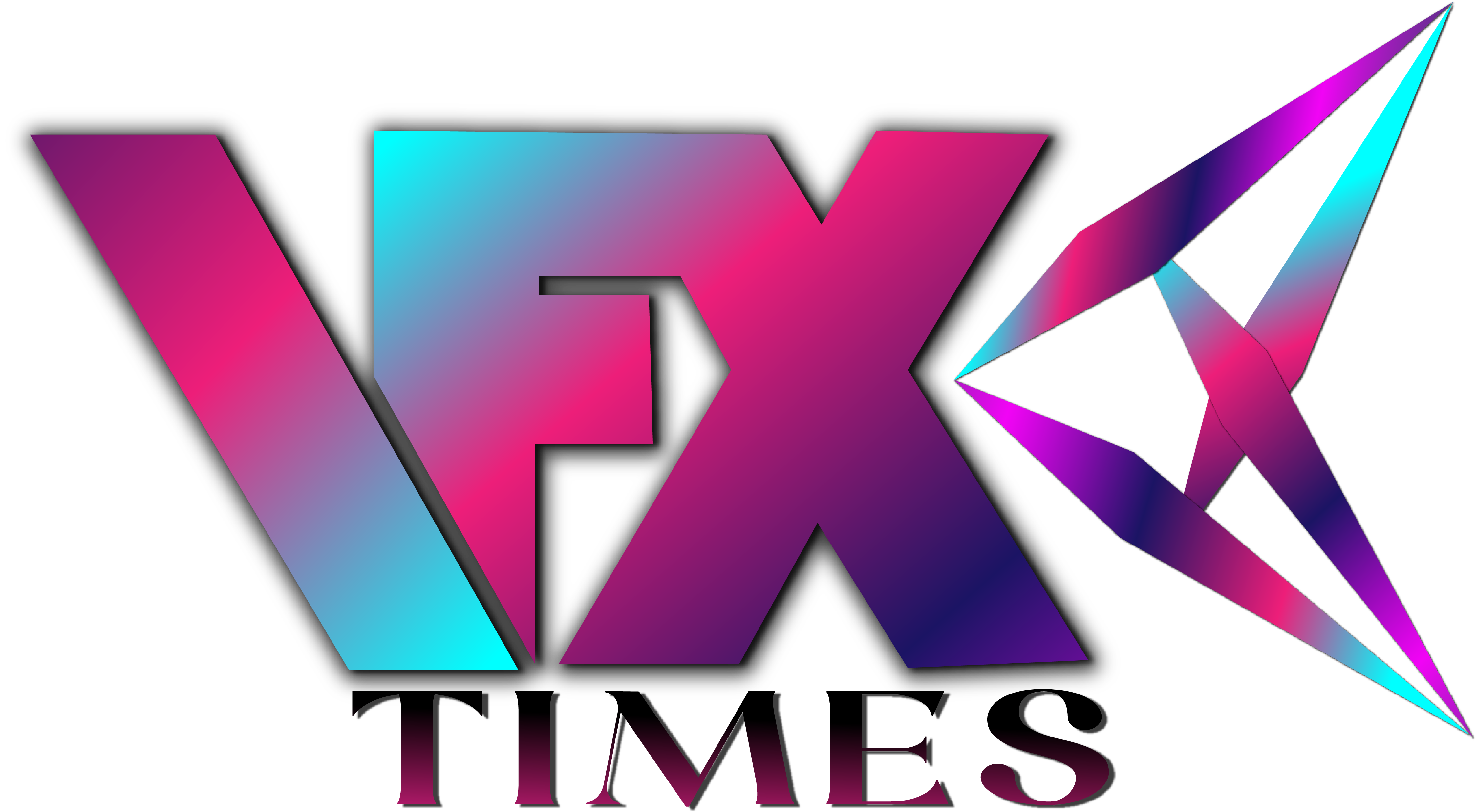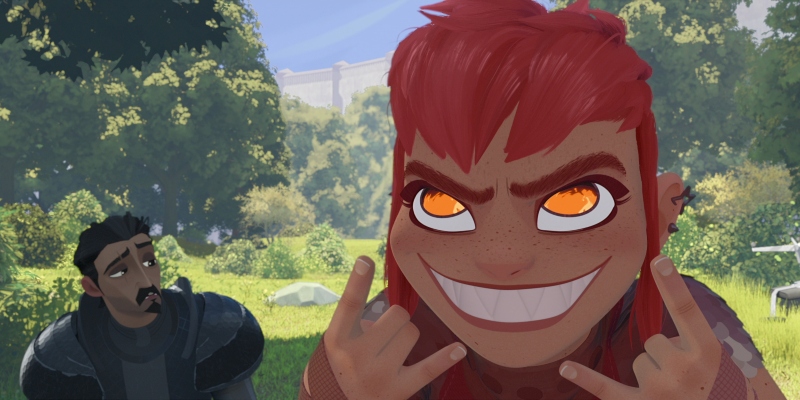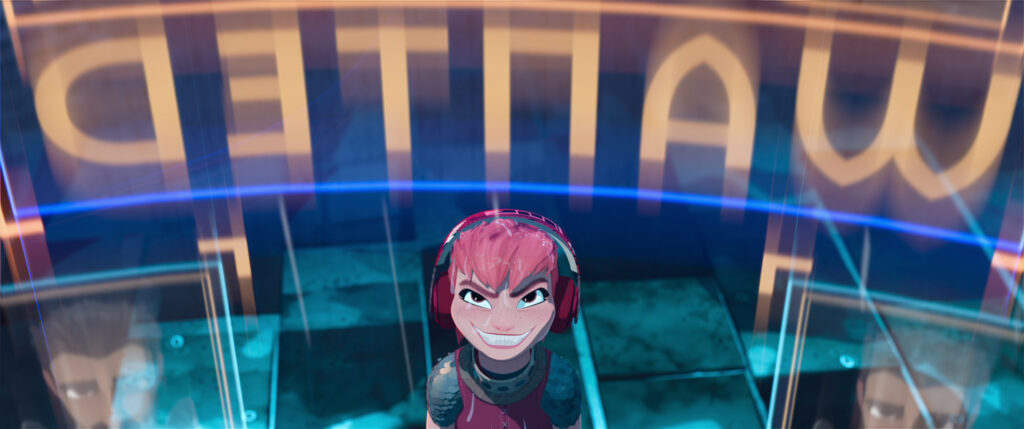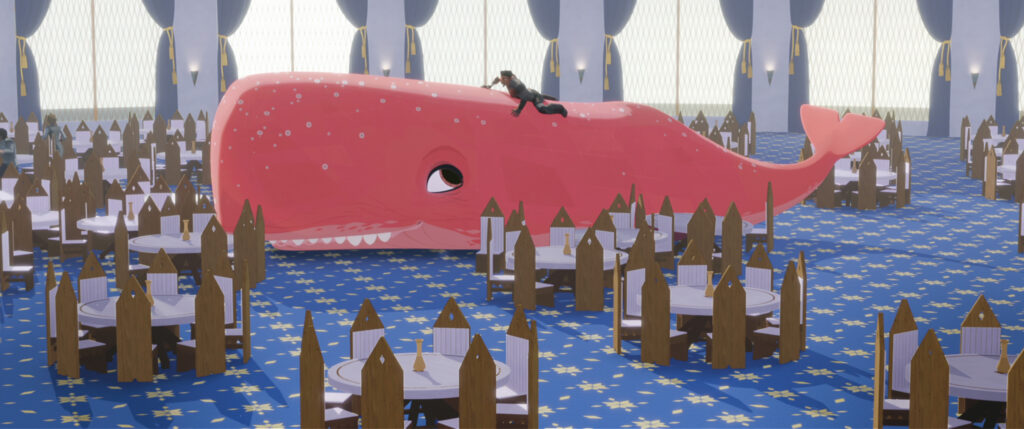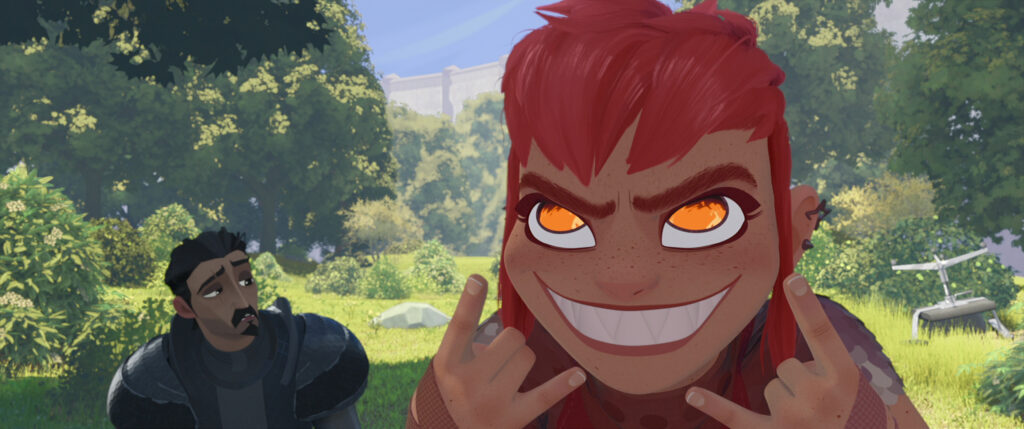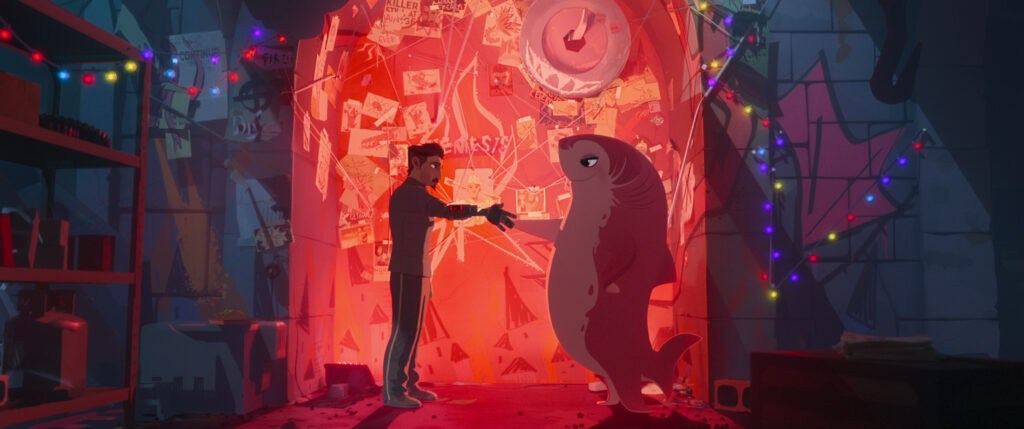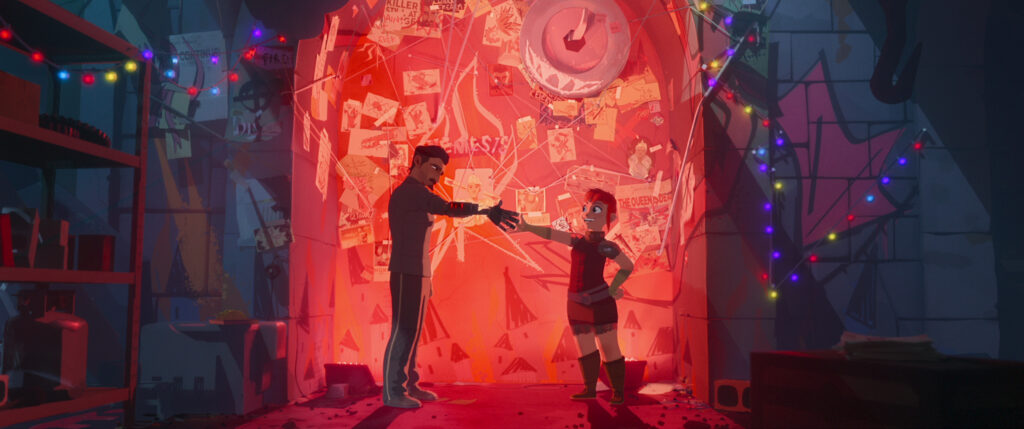Since its release on Netflix, praise has not stopped for the animated film Nimona. From its unique animation style to its story and lead character, the feature film is refreshing in its storytelling.
Based on the New York Times best-selling graphic novel of the same name by ND Stevenson, and directed by Nick Bruno and Troy Quane, Nimona is a tale about finding friendship and accepting yourself and others for who they are. The feature is brought to life by the DNEG Animation crew.
Here’s a synopsis of the film: When Ballister Boldheart (voiced by Riz Ahmed), a knight in a futuristic medieval world, is framed for a crime he didn’t commit, the only one who can help him prove his innocence is Nimona (voiced by Chloë Grace Moretz), a mischievous teen with a taste for mayhem — who also happens to be a shapeshifting creature he’s been trained to destroy. But with the entire kingdom out to get him, she’s the best (or technically the only) sidekick Ballister can hope for. And as the lines between heroes, villains, and monsters start to blur, the two of them set out to wreak serious havoc — for Ballister to clear his name once and for all, and for Nimona to…just wreak serious havoc.
The journey of bringing Nimona to life was marked by perseverance and adaptation, navigating through numerous hurdles from script to screen. Initially, Blue Sky Studios had taken the reins, optioning the rights for the movie and investing significant efforts into look and character development. However, the studio’s closure in April 2021 posed a significant setback. Undeterred by the challenges, the filmmaking team exhibited unwavering determination to keep the project alive. Ultimately, the collaboration between the production company Annapurna, Shapeshifter Films, and the resilient spirit of DNEG Animation led to the film’s revival and the realisation of its unique vision.
We spoke to Nimona’s animation director Ted Ty, VFX supervisor Archie Donato and digital producer Anthony Kemp who shared insights on reconstructing and redeveloping the look of the feature, expanding the environments and bringing to life the personalities and performances of the animated cast.
Here’s the full interview:
Anthony, as a digital producer, what is your role in an animated film, and what was it in Nimona?
Anthony Kemp: As digital producer, my job is to ensure all digital assets and imagery are successfully completed and delivered to the client. For Nimona, this included all assets, all sequences and shots, as well as the titles and end credits. I oversaw the entire production process, schedule, and budget and partnered with my VFX supes, Yancy and Archie, to guide our creative teams toward hitting the high creative benchmarks across all departments within the time we had to complete the film. Since we had to build a team of over 1,120 unique artists and production leaders in order to complete Nimona, I also partnered with our Recruiting and Resource Management teams to hire and onboard a large portion of the Nimona crew into DNEG.
From the time that DNEG was brought on board, how many days did it take to complete the project?
Kemp: Our work at DNEG took roughly 20 months of production from the time we started our initial ingest to final delivery to post.
Which all DNEG branches have worked on Nimona?
Kemp: We had a globally distributed crew across six DNEG branch hubs. Remote workers spanned 10 countries, 12 time zones and included over 1,120 individual contributors.
Was it a challenge to visually represent Nimona? Could you elaborate on how you achieved the visuals?
VFX supervisor Archie Donato: Nimona had a very complex road prior to reaching us at DNEG Animation. There had been development work done at Blue Sky Studios but most of it needed to be redeveloped from scratch because the directors wanted to push the look a lot further towards the graphic novel look. (Also the DNEG and Blue Sky pipelines were dramatically different, which prevented us from inheriting any of the previous look dev).
We were presented with a unique challenge since we needed to move away from the traditional CG approach of shaping the lighting and texture into a more flat, two dimensional look. This meant that we would completely move away from the ambient occlusion (commonly used on most CG feature films) and find a more selective approach to occluding the light in a painterly fashion.
We also developed several proprietary tools to accomplish the graphic look using in-house filtering and the most important aspect of this was to break out individual elements that make up a character into the stand alone render passes so that we could treat those components individually before reassembling the image back. So that means going way deeper into the use of AOVs, where instead of breaking out traditional specular highlights, difference, bounce etc…we ended up breaking out many more components to have creative control over each individual component.
When DNEG came on board, the Blue Sky team had already developed the look and characters, and your team developed them further. Could you tell us a bit more about this process? Also, what do you think is more challenging – developing something from scratch or redeveloping something?
Donato: As I mentioned above, there was some look development done at Blue Sky but we at DNEG could not use any of it because, per our directors, Nick and Troy, the look needed to be pushed a lot further, so the look development was started from scratch at DNEG. Also due to dramatic differences in the pipelines between the two companies it was not possible to reuse their look-dev. To your second question, it is considerably harder to redevelop the look than start from scratch. You have to take into consideration that each company approaches things so differently. But Nick and Troy knew exactly what they were looking for and we knew that we needed to start from scratch to accomplish what they intended the look to be.
The animation style is quite distinct from what people have seen before. Could you tell us more about this 3D-2D mix?
Animation director Ted Ty: The shape language of the film is tied into all elements of the film and the characters are no exception. The “2D” aspect of the animation felt present because we made use of silhouettes as much as possible for the legibility of the characters, and put them in profile much more than the average animated film. The 2D aspect also ties into older 2D hand drawn techniques of helping characters’ directionality, both physically and emotionally be more clear. And of course, it was also to tie our animation a little closer to the feel of ND Stevensons’ graphic comic book feel as well.
I had the most laughs on Nimona’s expression. To me as a viewer, her expressions played a major role in her character. Could you give us an insight on the varied expressions of the character?
Ty: It’s great that you enjoyed her expressions! They were really exciting to explore, because she is so dynamic and unpredictable. It was a fun challenge for our animation team because Nimona is very emotionally driven, but also has such a wide dynamic emotional range – meaning she could be very explosive one minute and very quiet and inward the next. Collaborating with our directors Nick and Troy, we focused on making certain that we were sure of her emotional intention before animating in order to make her expressions be as specific to the emotions of that particular scene in the story. That way, her expressions deliver the full performance potential to the audience.
The character of Nimona shapeshifts to multiple different animals. But each animal she transitions to, retains her quirk, and one can feel her talking even if it’s an animal avatar. How difficult was that to achieve?
Ty: It was indeed a challenge. It’s impossible to determine which form was actually Nimona, because she is not defined by any form unless she chooses to transform into it. In other words, we had to think about the shark, whale, gorilla, etc. as Nimona’s true form at any given time, and it was more about making her behaviours consistent across all animal and human forms as opposed to taking the gestures and idiosyncrasies of girl Nimona and putting them on the animal forms. We used more obvious things like her eye and eyebrow behavior to link her personalities across all her forms, but also less visible things like the timing of her head for instance. A really fun aspect of animating her different forms was not only keeping her behaviour consistent, but to also imbue each form with movement based on that particular animals’ traits – a quick mouse all the way to a powerful gorilla.
Even while Nimona has devil teeth, her character and look manage to exude all things positive. How was that done?
Ty: The teeth were a really entertaining aspect of Nimona, and essentially, our character rigs had different sets of teeth that we could change and modify, depending on the extremes necessary in that moment and expression. It could have been as subtle as shaping her canines to be a little more pointy when Nimona is feeling mischievous, like when she’s a shark – like at very “metal” moments.
There is a lot of between the lines and symbolism in this film, in terms of light and colour. How important is that to the storytelling of any film? Can you share some examples from Nimona?
Donato: Here I have to give all credit to our incredible production designer Aidan Sugano. He had a very clear colour script of the film which was designed to assist the storytelling. Aidan was able to guide us through this process and was able to paint us some incredible color keys for us to work from. I would entirely defer to him on this question.
In terms of technology/software/production, is there anything that required a different approach than your previous projects?
Donato: Given how stylised the look needed to be, very early we decided to not put ourselves in the box from the technology and software side. Instead we wanted to allow artists to decide what was the best way to approach the look of the show. For example our Motion Graphics team had to generate literally thousands of elements so they were able to utilise software and technology as needed without being tied down by the pipeline constraints.
What was the most challenging to work on, including the most difficult scene in the film?
Donato: Without a doubt it was the Shadow Creature destroying the city – that was by far the most challenging set of the sequences.
Could you each tell us what you enjoyed working on the most?
Donato: To me personally, accomplishing the graphic 2D look of the film in 3D was the most difficult and at the same time the most rewarding part of the film.
Ty: It was making sure that we managed to extract the full acting potential of the fantastic vocal performances, script and story. It is rare to have such layered and deep characters with profound “souls” and finding the right choices in the performances with the animation team to deliver what the directors were looking for – and more – was really enjoyable.
Kemp: Working with our crew was the biggest joy of this experience for me. We had an incredible (and sometimes “impossible”) task of bringing artists and their work together from all across the globe, but every time we managed to create another stunning sequence, it was a reminder of the miracle of what we could accomplish with that level of talent and passion.
Tell us your personal experiences of working on Nimona.
Donato: For me this film was by far the most important animated project of my career due to its message of acceptance of everyone regardless of their background. This message drove myself and my team to go above and beyond to make this film look as amazing as possible.
Ty: This was a difficult but rewarding film to make because the message, tone and the “life” of the film drove us in animation to always push for more – a higher level of honesty and truthfulness in the performances. It was incredibly inspiring to help contribute to a film with such an incredible message of self-acceptance, and the acceptance of others. We feel very fortunate to have helped craft Nimona.
How was the experience working with directors Nick Bruno & Troy Quane?
Donato: For us Nick and Troy were such a wealth of information about every tiny detail of the film that it made my job as a VFX supervisor a lot easier by having constant access to our directors. I used to email or call Nick and Troy and they were fantastic in getting back to us with answers immediately. I also want to mention that their support to us as a team was absolutely phenomenal since we at DNEG had to hit the ground running since we did not have six to seven months of early production to learn all the intricate details.
Ty: Nick and Troy are both very accomplished animators in their own right, so working with them to shape the characters’ performances was that much more precise and specific. They have really sharp eyes for animation, and know the characters so well and that helped to guide our animation. They were incredibly collaborative and lent a great deal of trust to me and my animation team – allowing us to bring fresh ideas and encouraging us to push for more in the performances all the time throughout the film. The fact that they are really funny guys also made it that much easier to work with them every day.
DNEG Animation is currently working on the animated feature Garfield produced by Alcon Entertainment, which will hit theatres in May 2024. The studio also has in works That Christmas which is based on a children’s book, with producer Locksmith Animation.
